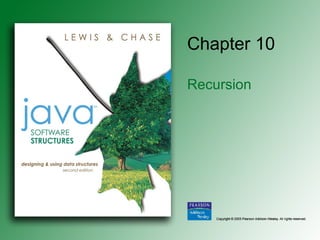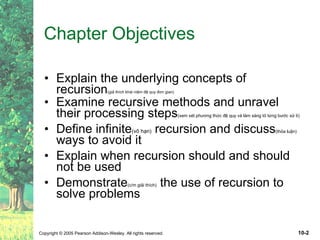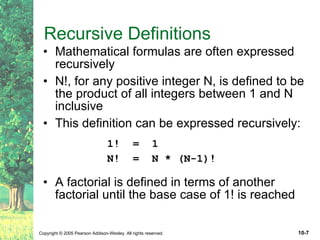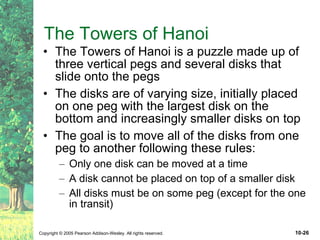Ch10 Recursion
- 2. Chapter Objectives Explain the underlying concepts of recursion (giả thích khái niệm đệ quy đơn gian) Examine recursive methods and unravel their processing steps (xem xét phương thức đệ quy và làm sáng tỏ từng bước xử lí) Define infinite (vô hạn) recursion and discuss (thỏa luận) ways to avoid it Explain when recursion should and should not be used Demonstrate (c/m giải thích) the use of recursion to solve problems
- 3. Recursive Thinking Recursion is a programming technique in which a method can call itself to solve a problem A recursive definition is one which uses the word or concept being defined in the definition itself In some situations, a recursive definition can be an appropriate way to express a concept Before applying recursion to programming, it is best to practice thinking recursively
- 4. Recursive Definitions Consider the following list of numbers: 24, 88, 40, 37 Such a list can be defined recursively: A LIST is a: number or a: number comma LIST That is, a LIST can be a number, or a number followed by a comma followed by a LIST The concept of a LIST is used to define itself
- 5. FIGURE 10.1 Tracing the recursive definition of a list
- 6. Infinite Recursion All recursive definitions must have a non-recursive part If they don't, there is no way to terminate the recursive path A definition without a non-recursive part causes infinite recursion This problem is similar to an infinite loop -- with the definition itself causing the infinite "looping" The non-recursive part often is called the base case
- 7. Recursive Definitions Mathematical formulas are often expressed recursively N!, for any positive integer N, is defined to be the product of all integers between 1 and N inclusive This definition can be expressed recursively: 1! = 1 N! = N * (N-1)! A factorial is defined in terms of another factorial until the base case of 1! is reached
- 8. Recursive Programming A method in Java can invoke itself; if set up that way, it is called a recursive method The code of a recursive method must be structured to handle both the base case and the recursive case Each call sets up a new execution environment, with new parameters and new local variables As always, when the method completes, control returns to the method that invoked it (which may be another version of itself)
- 9. Recursive Programming Consider the problem of computing the sum of all the numbers between 1 and N, inclusive If N is 5, the sum is 1 + 2 + 3 + 4 + 5 This problem can be expressed recursively as: The sum of 1 to N is N plus the sum of 1 to N-1
- 10. FIGURE 10.2 The sum of the numbers 1 through N, defined recursively
- 11. Recursive Programming public int sum (int num) { int result; if (num == 1) result = 1; else result = num + sum(num-1); return result; }
- 12. FIGURE 10.3 Recursive calls to the sum method
- 13. Recursion vs. Iteration Just because we can use recursion to solve a problem, doesn't mean we should For instance, we usually would not use recursion to solve the sum of 1 to N The iterative version is easier to understand (in fact there is a formula that is superior to both recursion and iteration in this case) You must be able to determine when recursion is the correct technique to use
- 14. Recursion vs. Iteration Every recursive solution has a corresponding iterative solution For example, the sum of the numbers between 1 and N can be calculated with a loop Recursion has the overhead of multiple method invocations However, for some problems recursive solutions are often more simple and elegant than iterative solutions
- 15. Indirect Recursion A method invoking itself is considered to be direct recursion A method could invoke another method, which invokes another, etc., until eventually the original method is invoked again For example, method m1 could invoke m2, which invokes m3, which invokes m1 again This is called indirect recursion It is often more difficult to trace and debug
- 16. FIGURE 10.4 Indirect recursion
- 17. Maze Traversal Let's use recursion to find a path through a maze A path can be found through a maze from location x if a path can be found from any of the locations neighboring x We can mark each location we encounter as "visited" and then attempt to find a path from that location's unvisited neighbors
- 18. Maze Traversal Recursion will be used to keep track of the path through the maze using the run-time stack The base cases are a prohibited (blocked) move, or arrival at the final destination
- 19. Listing 10.1
- 20. Listing 10.2
- 21. Listing 10.2 (cont.)
- 22. Listing 10.2 (cont.)
- 23. Listing 10.2 (cont.)
- 24. Listing 10.2 (cont.)
- 25. FIGURE 10.5 UML description of the Maze and MazeSearch classes
- 26. The Towers of Hanoi The Towers of Hanoi is a puzzle made up of three vertical pegs and several disks that slide onto the pegs The disks are of varying size, initially placed on one peg with the largest disk on the bottom and increasingly smaller disks on top The goal is to move all of the disks from one peg to another following these rules: Only one disk can be moved at a time A disk cannot be placed on top of a smaller disk All disks must be on some peg (except for the one in transit)
- 27. FIGURE 10.6 The Towers of Hanoi puzzle
- 28. FIGURE 10.7 A solution to the three-disk Towers of Hanoi puzzle
- 29. Towers of Hanoi To move a stack of N disks from the original peg to the destination peg: Move the topmost N-1 disks from the original peg to the extra peg Move the largest disk from the original peg to the destination peg Move the N-1 disks from the extra peg to the destination peg The base case occurs when a "stack" contains only one disk
- 30. Towers of Hanoi Note that the number of moves increases exponentially as the number of disks increases The recursive solution is simple and elegant to express (and program) An iterative solution to this problem is much more complex
- 31. Listing 10.3
- 32. Listing 10.3 (cont.)
- 33. Listing 10.4
- 34. Listing 10.4 (cont.)
- 35. Listing 10.4 (cont.)
- 36. FIGURE 10.8 UML description of the SolveTowers and TowersofHanoi classes
- 37. Analyzing Recursive Algorithms When analyzing a loop, we determine the order of the loop body and multiply it by the number of times the loop is executed Recursive analysis is similar We determine the order of the method body and multiply it by the order of the recursion (the number of times the recursive definition is followed)
- 38. Analyzing Recursive Algorithms For the Towers of Hanoi, the size of the problem is the number of disks and the operation of interest is moving one disk Except for the base case, each recursive call results in calling itself twice more To solve a problem of N disks, we make 2 N -1 disk moves Therefore the algorithm is O(2 n ), which is called exponential complexity





































